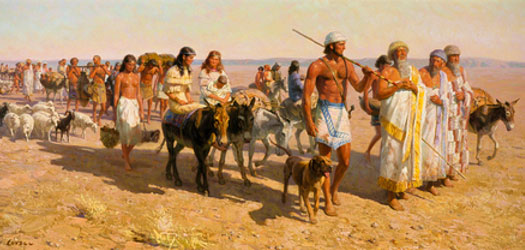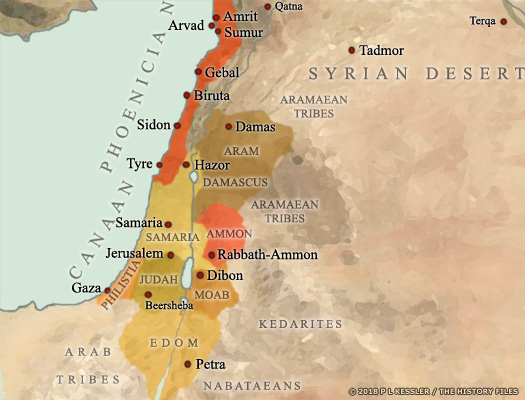
| AMMON The people of Ammon were Semitic Canaanites, known by the Bible as the 'children of Ammon'. Their kingdom was situated east of the River Jordan, and the people were closely related to the Israelites, Moabites, and Edomites. Although their western border was clearly defined after they lost the territory beyond it first to an Amorite invader and then to the Israelites in about 1200 BC, their eastern borders were never clearly defined, opening out as they did onto the Syrian Desert. The southern border was shared with Moab, while to the north it may have met the border of the city state of Geshur. The kingdom's key city was Rabbah, or Rabbath Ammon, which survives today as Amman, the capital of the kingdom of Jordan. A good source of wealth was the fact that Ammon lay along the 'King's Highway', an important north-south trade route between Egypt, Syria, and Mesopotamia.
Akkadian sources which date to the kingdom's earliest years of existence mention nomadic groups along the Trans-Jordanian highlands whom they term the Shutu. These groups extend deep into Mesopotamia, probably occupying the edges of the habitable zone there. Speculation about the Shutu mentions that the name may be a variant of the Egyptian term 'Shasu', Semitic cattle-herding nomads who operated in a clan system with tribal chieftains. While the historical identity of these Shutu is unknown, they have been linked to the Moabites and Ammonites.
The Ammonites were worshippers of Molech, an old Canaanite idol who was known as Melkarth, Baal-melech, Malcom, and other such names by the Phoenicians and Carthaginians. he was related to Baal, a sun-god worshipped by the sacrifice of children. According to Unger's Bible Dictionary, Palestinian excavations have uncovered evidences of infant skeletons in burial places around heathen shrines. The Moabite god, Chemosh, may have been closely related to Molech, or a substitute for him.
(Information by Peter Kessler, with additional information from Unger's Bible Dictionary, Merrill F Unger (1957), from Easton's Bible Dictionary, Matthew George Easton (1897), from Egypt, Canaan and Israel in Ancient Times, Donald Redford (Princeton University Press, 1992), from Early Israel and the Surrounding Nations, A H Sayce, and from External Link: Encyclopædia Britannica.)
c.1740 BC :
Ben Ammi : Son of Lot, who was nephew to Abraham. First king of Ammon.
c.1740 BC :
According to the Old Testament, the Ammonites are descended from Ben Ammi, an illegitimate son of Lot and a grandnephew of Abraham of the early Israelites. The early close relations between Ammon and the kingdom of Moab are confirmed by their later history and both groups have to expel native groups to claim their land, the Emim in Moab and the Rephaim Zuzim in Ammon. These two groups may essentially be one and the same people, regarded as brigands by larger states but probably nothing more than nomadic, cattle-herding pastoralists who mount the occasional raid. The Rephaim Zuzim are referred to as giants, a label often used to mark out indigenous people who are defeated by newcomers (Finns, Germanics, and Celts in Britain all have similar references, for example).
This slightly fanciful view of the migrating Israelites does show a surprisingly small number of participants (more are cropped off from the left, but even so their numbers are very finite), something that chimes with the 'ruling elite' theory of migration detailed in the introduction on the Israelites page 17th cent BC :
An Egyptian execration text dated to the seventeenth century BC refers to an 'Ayyab' as king of the Shutu. The name is possibly a variant form of 'Job', with Jobab of Edom being a handy candidate. However, tentative identification of the mysterious Shutu has linked them with the Moabites and Ammonites to the north of Edom.
1453 BC :
The Egyptians conquer the Levant and Syria and establish three provinces in their conquered territories which are named Amurru (in southern Syria), Upe (in the northern Levant), and Canaan (in the southern Levant). Each one is governed by an Egyptian official. Native dynasts are allowed to continue their rule over the small states, but it is not known whether Ammon is included, or indeed if it has a single head of state at this time.
1286/1258 BC :
Ramses II of Egypt reaches a stalemate with the Hittites at the Battle of Kadesh, after which the earliest known peace treaty is signed in 1258 BC. Ramses limits his control to southern Palestine, where he draws a firm and fortified boundary. He is also known during his reign as the oppressor of the Israelites, possibly the unnamed pharaoh of the Old Testament, but whether the well-known story of the Israelite exodus from Egypt occurs at this point in time is still unproven and highly debatable.
c.1150 BC :
After apparently being militarily dominant since their arrival half a century before, the Israelites suffer a reversal in fortunes when at least some of them are subdued by Moab, possibly with support provided by Ammon. More of their territory, in the south, is conquered by the Philistines who maintain vassal kings in Israel.
fl c.1115 BC :
Sihon : Amorite ruler of parts of Moab and Ammon.
c.1115 BC :
According to the Old Testament, Sihon, an Amorite, captures areas of Moab ('from Arnon even unto Jabbok and unto Jordan'), and forms his own kingdom around the city of Heshbon. He is referred to as a king of Ammon by the Israelites when they make contact and he refuses to allow them to return from Egypt to Canaan through his western territories. In retaliation they attack and capture his walled towns, including Heshbon, wiping out his people. His land becomes part of Israel. This is a bone of contention with the Ammonites, who would rather have their territory returned to them. The upper waters of the Jabbok now form their western border.
c.1050 BC :
A weakened Egypt loses its remaining imperial possessions in Canaan. At the same time, Ammon appears to gain a recognisable line of kings for the first time.
fl 1050s - 1000 BC :
Nahash : Attacked Jabesh-Gilead.
c.1000 BC :
The Israelite king Saul defeats Nahash after the citizens of the frontier city of Jabesh-Gilead call for assistance against the Ammonite army. A small nation, the Ammonites are not strong enough to stand against the Israelites without support, which is usually received from Moab.
early 900s BC :
Hanun ben Nahash : Son.
c.980 BC :
Ammon is conquered by Israel, despite assistance being supplied by the northern state of Aram Damascus. King David appoints Sobi as the new king to keep the peace, successfully, it seems, as relations visibly improve between the two states.
Sobi ben Nahash / Shobi : Brother? Vassal of Israel.
early/mid-900s BC :
? : Vassal of Israel.
c.880 BC :
Ammon regains its independence after a period of hostilities provoked by the kings of Samaria. It is possible that the state becomes a vassal of Damas for a time, but this is uncertain.
c. 870s - 860s BC :
Ruhubi
fl 860s / 853 BC :
Ba'asa (the Ammonite) / Baasha : Son. Ruler of Bit-Ruhubi (Ammon).
860s? BC :
Asa of Judah and Ba'asa (Baasha) of Ammon maintain a near-lifelong feud. When Ba'asa pushes Samaria's frontier to within five miles of Jerusalem, Asa, just like his father before him when under pressure, calls on Damas for help. In this case it is Ben-Hadad who responds to Asa's offer of payment if Damas will break its treaty with Ammon.
853 BC :
Ba'asa is a member of an alliance of states which also includes Arvad, Byblos, Damas, Edom, Egypt, Hamath, Kedar, and Samaria. Together they fight Shalmaneser III of Assyria at the Battle of Qarqar which consists of the largest known number of combatants in a single battle to date, and is the first historical mention of the Arabs from the southern deserts. Despite claims to the contrary, the Assyrians are defeated, since they do not press on to their nearest target, Hamath, and do not resume their attacks on Hamath and Damas for about six years.
When the Neo-Assyrian empire threatened the various city states of southern Syria and Canaan around 853 BC, they united to protect their joint territory - successfully it seems, at least for a time c.740 BC :
Ammon is made a vassal of Assyria. Assyrian tribute lists show that Ammon is a poor country, contributing as it does tribute just one-fifth of the size of that from Judah.
fl c.740 BC :
Budili : Known only in Assyrian records. Ammonite name lost.
fl c.735 BC :
Shanip / Sanipu
fl before 701 BC :
Pado'el / Pudu'ilu
fl 680s BC :
Kabus-Gabri ELSM? : Inscription. No other known records.
fl c.675 BC :
Barak-el MNHRN? : Inscription. No other known records.
fl c.650 BC :
Amminadab I
fl c.620 BC :
Hissal'el I ben Amminadab : Son.
fl c.600 BC :
Amminadab II ben Hissal'el : Son.
c.590s - 585 BC :
Baalis
597 BC :
Nebuchadnezzar of Babylonia invades Judah and occupies Jerusalem (with the help of Ammon). Despite this, Baalis still receives Jews who flee Babylonian rule.
c.585 BC :
Baalis instigates the murder of the Babylonian governor of Judah, and Ammon is soon made a vassal of Babylonia.
fl c.585 BC :
Milcomur
fl c.580s BC :
Tobiah I
c.539 BC :
Ammon is made a vassal of Persia. There are few mentions of Ammon in this period.
fl c.520s BC :
Tobiah II
fl mid-400s BC :
Tobiah III : Governor?
446 - 444 BC :
Tobiah incites the Ammonites to hinder Ezra and Nehemiah's efforts to rebuild Jerusalem in Judah.
c.332 - 323 BC :
Ammon is made a vassal of the Greek empire under Alexander the Great.
c.323 -200 BC :
Alexander the Great's general, Seleucus, take control of the region. In 305 BC his domains become the Seleucid empire.
c.270 BC :
The city Rabbath Ammon is renamed Philadelphia in honour of Ptolemy II of Egypt, possibly around this date which is when he takes the name himself.
fl c.270 BC :
Tobiah IV
fl c.200 BC :
Tobiah V
200 - 195 BC :
To achieve his part of a treaty with Philip V of Macedonia that is designed to carve up Egypt's colonial possessions, Antiochus III of the Seleucid empire invades Coele Syria. This triggers the Fifth Syrian War and sees Ptolemaic General Scopas defeated at Panion near the source of the River Jordan in 200 BC. This gains Antiochus control of Palestine and Phoenicia (which includes the city of Miletus). The campaign ends in a peace deal in 195 BC which gains for Antiochus permanent possession of southern Syria (which includes Idumaea), while Ammon takes advantage of the shift in power to declare its own independence.
? - 160 BC :
Timotheus
c.160 BC :
Timotheus is defeated by the Maccabaean Jews and control of Ammon passes to them in a newly independent Judea.
120s - 110s BC :
Zoilus Cotylas : Tyrant of Philadelphia.
c.110 - 85 BC :
Philadelphia within the Dekapolis.
late 100s - 90s? BC :
Theodoros : Tyrant of Philadelphia.
87 - 63 BC :
The Seleucid King Antiochus XII attacks the Nabataeans, intent on recapturing lost territory from them, but although he kills their king, the Nabataeans resist his advance. To make it worse, their new king strikes back and takes southern Syria and Ammon. Ammon remains a Nabataean territory until 63 BC.
64 - 63 BC :
The region is conquered by Pompey of Rome and becomes a province. Ammonites are still numerous in the south of Palestine into the second century AD.
Source :
https://www.historyfiles.co.uk/ |

